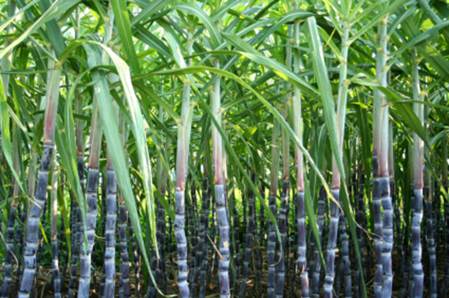把甘蔗变成航空燃料
来源:《PNAS》
作者:Madhesan Balakrishnan等
时间:2015-06-23
 图一
图一
 图二
图二
来自美国加州大学伯克利分校的研究人员成功以甘蔗为原料生产出航空燃料(图二右上)和润滑油(图二右中、右下)
来自美国的一个研究小组近日成功以甘蔗为原料,以较高的产率生产出航空燃料,实现了生物燃料技术的新突破。
为了减轻温室效应并减少对化石燃料的依赖,来自世界各地的研究人员致力于将植物转化为燃料以及其他重要的化工原料并取得了一定的进展,各种形式的生物燃料已经开始在机动车辆中使用。然而以植物为原料生产航空燃料仍然面临着极大的困难,这是因为航空燃料对燃料的物理和化学性质要求很高,例如用于航空燃料的有机物不能含有氧元素,而且必须具有足够低的凝固点和粘度。符合这些要求的有机物通常是具有支链或者环状结构的脂肪族烷烃,而这类化合物很难通过现有技术从植物中转化而来,仅有的一些成功的例子往往也存在着产率低、能耗大等缺点。
美国加州大学伯克利分校Alexis T. Bell教授领导的研究小组近日成功开发出以植物为原料生产航空燃料的技术。他们首先将甘蔗中的蔗糖和半纤维素转化为酮类化合物,再通过一系列缩合、脱氧等反应将这些化合物转化为烷烃。整个反应过程使用廉价且可回收的催化剂,并且产率极高。这些化合物的性能与目前使用的航空燃料接近,能量密度甚至高于现有的航空燃料。利用类似的方法,他们还成功以甘蔗为原料生产出一系列高性能润滑油。分析表明,如果用这种来自甘蔗的航空燃料代替传统的航空燃料,温室气体排放量可以降低近80%。(来源:科学公园)
Novel pathways for fuels and lubricants from biomass optimized using life-cycle greenhouse gas assessment
Abstract Decarbonizing the transportation sector is critical to achieving global climate change mitigation. Although biofuels will play an important role in conventional gasoline and diesel applications, bioderived solutions are particularly important in jet fuels and lubricants, for which no other viable renewable alternatives exist. Producing compounds for jet fuel and lubricant base oil applications often requires upgrading fermentation products, such as alcohols and ketones, to reach the appropriate molecular-weight range. Ketones possess both electrophilic and nucleophilic functionality, which allows them to be used as building blocks similar to alkenes and aromatics in a petroleum refining complex. Here, we develop a method for selectively upgrading biomass-derived alkyl methyl ketones with >95% yields into trimer condensates, which can then be hydrodeoxygenated in near-quantitative yields to give a new class of cycloalkane compounds. The basic chemistry developed here can be tailored for aviation fuels as well as lubricants by changing the production strategy. We also demonstrate that a sugarcane biorefinery could use natural synergies between various routes to produce a mixture of lubricant base oils and jet fuels that achieve net life-cycle greenhouse gas savings of up to 80%.
原文链接:http://www.pnas.org/content/early/2015/06/03/1508274112.full.pdf




